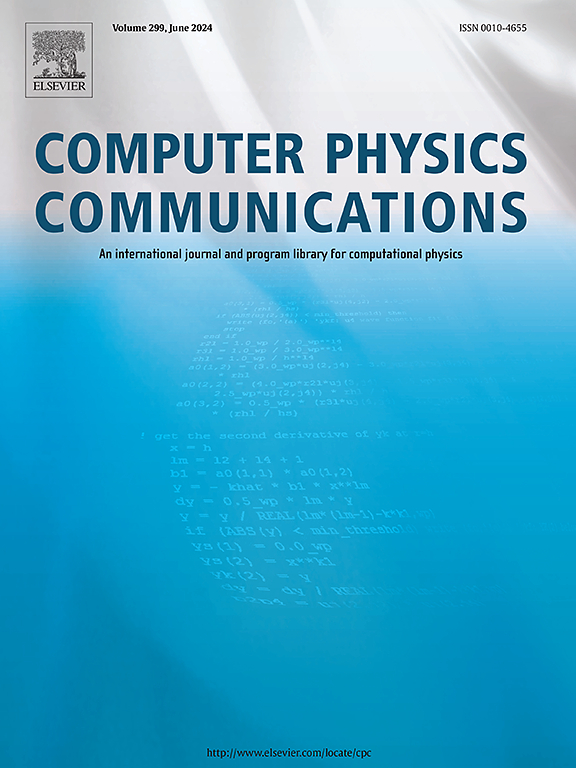QWAK:量子行走分析试剂盒
IF 3.4
2区 物理与天体物理
Q1 COMPUTER SCIENCE, INTERDISCIPLINARY APPLICATIONS
引用次数: 0
摘要
在本文中,我们描述了Python 3的连续时间量子行走(CTQW)仿真包,涵盖了它们的理论基础和实际应用。该软件提供了一般图形的统一和开放系统演化,以及用于可视化和探索量子行走几个不同方面的工具。我们将介绍该软件包的安装、设计和性能,最后给出几个示例,说明如何使用QWAK来探索搜索、完美状态转移等问题。此外,我们还演示了如何利用CuPy来利用GPU加速。程序摘要/新版本程序摘要程序标题:QWAKCPC库链接到程序文件:https://doi.org/10.17632/wyrm54zc3f.1Developer's存储库链接:https://github.com/JaimePSantos/QWAKLicensing条款:CC By 4.0编程语言:Python, Javascript, HTML和CSS。问题性质:QWAK模拟单一和随机连续时间量子行走,重点是传输特性分析,应用,可视化和易用性。解决方法:我们利用Python的大量包资源(如NumPy和NetworkX)来实现所需的结构,然后通过谱分解生成哈密顿量。对于随机情况,用Qutip求解了Lindblad主方程。附加评论,包括限制和不寻常的功能:提供的GUI使用MongoDB来存储QWAK对象,这目前限制了图的大小,因为邻接矩阵也被存储。本文章由计算机程序翻译,如有差异,请以英文原文为准。
QWAK: Quantum walk analysis kit
In this paper, we describe a continuous-time quantum walk (CTQW) simulation package for Python 3, covering their theoretical foundations and practical applications. The software provides both unitary and open system evolution of over general graphs, alongside tools for visualization and exploration of several different aspects of the quantum walk. We go over installation, design and performance of the package, concluding with several examples on how QWAK can be used to explore problems such as search, perfect state transfer, among others. Additionally, we demonstrate how CuPy is utilized to leverage GPU acceleration.
Program Summary/New Version Program Summary
Program Title: QWAK
CPC Library link to program files: https://doi.org/10.17632/wyrm54zc3f.1
Developer's repository link: https://github.com/JaimePSantos/QWAK
Licensing provisions: CC By 4.0
Programming language: Python, Javascript, HTML and CSS.
Nature of problem: QWAK simulates unitary and stochastic continuous-time quantum walks, focusing on transport property analysis, applications, visualization and ease of use.
Solution method: We leverage Python's vast package resources such as NumPy and NetworkX to implement the desired structures, and then generate the Hamiltonians via spectral decomposition. For the stochastic case, the Lindblad master equations are solved with Qutip.
Additional comments including restrictions and unusual features: The GUI provided uses MongoDB to store QWAK objects, which currently limits the size of the graphs since the adjacency matrices are also stored.
求助全文
通过发布文献求助,成功后即可免费获取论文全文。
去求助
来源期刊

Computer Physics Communications
物理-计算机:跨学科应用
CiteScore
12.10
自引率
3.20%
发文量
287
审稿时长
5.3 months
期刊介绍:
The focus of CPC is on contemporary computational methods and techniques and their implementation, the effectiveness of which will normally be evidenced by the author(s) within the context of a substantive problem in physics. Within this setting CPC publishes two types of paper.
Computer Programs in Physics (CPiP)
These papers describe significant computer programs to be archived in the CPC Program Library which is held in the Mendeley Data repository. The submitted software must be covered by an approved open source licence. Papers and associated computer programs that address a problem of contemporary interest in physics that cannot be solved by current software are particularly encouraged.
Computational Physics Papers (CP)
These are research papers in, but are not limited to, the following themes across computational physics and related disciplines.
mathematical and numerical methods and algorithms;
computational models including those associated with the design, control and analysis of experiments; and
algebraic computation.
Each will normally include software implementation and performance details. The software implementation should, ideally, be available via GitHub, Zenodo or an institutional repository.In addition, research papers on the impact of advanced computer architecture and special purpose computers on computing in the physical sciences and software topics related to, and of importance in, the physical sciences may be considered.
 求助内容:
求助内容: 应助结果提醒方式:
应助结果提醒方式:


